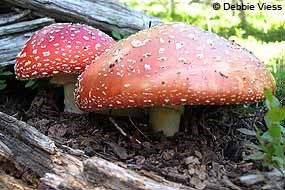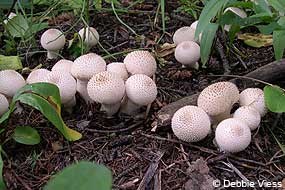
What are Mushrooms?Mushrooms are short-lived, spore-producing structures (akin to apples on a tree); they are designed to release spores, and then decay. Picking a mushroom does not harm the long-lived fungal organism. The "body" of a mushroom is hidden from our eyes, and is composed of a vast, branching network of tiny, elongate cells called hyphae. These hyphal threads grow through and break down dead wood, providing a vital recycling service to our forests. Fungal hyphae also live in the ground, and connect up with the rootlets of trees, shrubs and almost all other green plants, forming a symbiotic (mutually beneficial) relationship. This mycorrhizal (fungus-root) partnership greatly increases the ability of trees and plants to take up water, and absorb essential minerals. In return, the fungus is provided with photosynthetic nutrients. Neither organism is able to function fully without the other. Mushrooms at Point Reyes National SeashoreMushrooms are a vitally important aspect of the diverse, natural world of Point Reyes National Seashore. They are found in all types of park habitat, from Bishop pine forests to coast live oak woodlands, meadows to sand dunes. Mushrooms are not only vital to the health of the Point Reyes ecosystem, but they also add charm and magic to the landscape. Appearing seemingly overnight in response to rain, they come in a vast array of fantastic colors and shapes, from brilliant red, to purple, to golden orange, with caps ranging from the size of a pinhead, to as large as a dinner plate. A slow walk through almost any landscape during the mushroom season can produce a world of wonder at your feet. 
The best time to see mushrooms at Point Reyes National Seashore is starting from two weeks after the first, soaking fall rain, and on into the winter and spring. Fruiting is affected by the amount and frequency of rain (too much can be as bad as too little) as well as the temperature. Many variables affect whether mushrooms are produced, and even experienced collectors can't always predict when and where they will appear. There are specific legal guidelines for mushroom collecting. Please visit the Collecting section on our Park Regulations page for more information. Please note: employee housing as well as park administrative, maintenance, operations, and storage facilities, including, but not limited, to access roads, outbuildings, grounds, and docks, are closed to public use. No mushroom should be eaten unless it can first be positively identified as edible. Learning to identify mushrooms in their many guises takes time, and reliable resources. The best way to learn about mushrooms is through local field guides and mushroom societies. Visit the Bay Area Mycological Society's Mushroom Poisonings page for more information on identifying the three most deadly mushrooms in California. Download the Macrofungi of Point Reyes National Seashore species list (23 KB PDF, Adobe® Acrobat Reader® required). To learn more about mushrooms in the San Francisco Bay area visit the Bay Area Mycological Society website. And visit our Lichens page to learn about a unique partnership some fungi have developed with algae. Multimedia PresentationsFrom 2007 to 2012, Pacific Coast Science and Learning Center Science Communication Interns produced a series of podcasts, videos, and audio-slide shows exploring science from Bay Area national parks. One of these The Natural Laboratory multimedia products focused on the invasive death cap mushroom. Listen to the podcast below. Visit our Multimedia Presentations: The Natural Laboratory Audio Podcasts page for additional podcasts.
|
Last updated: January 6, 2026
